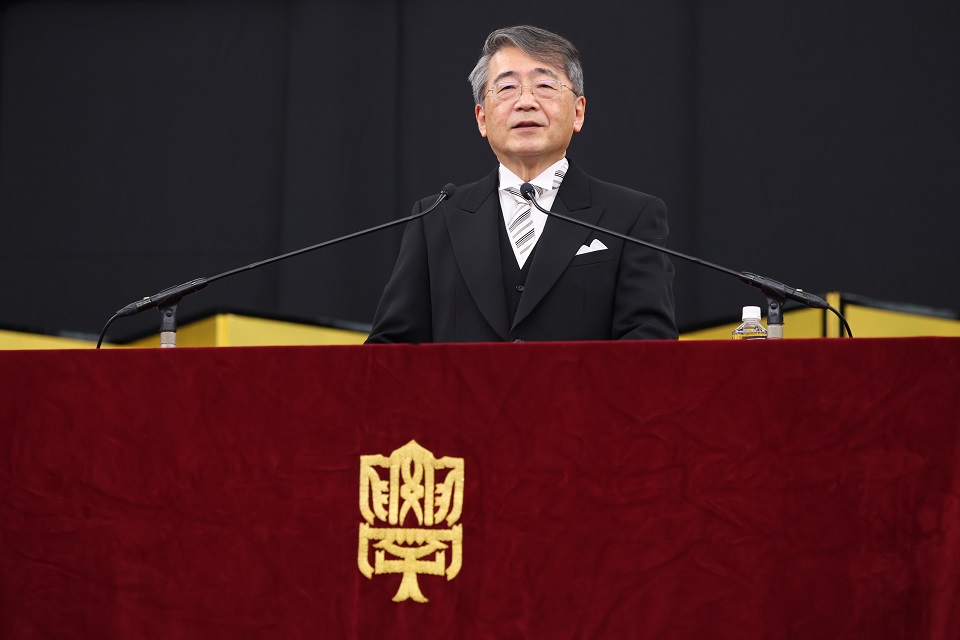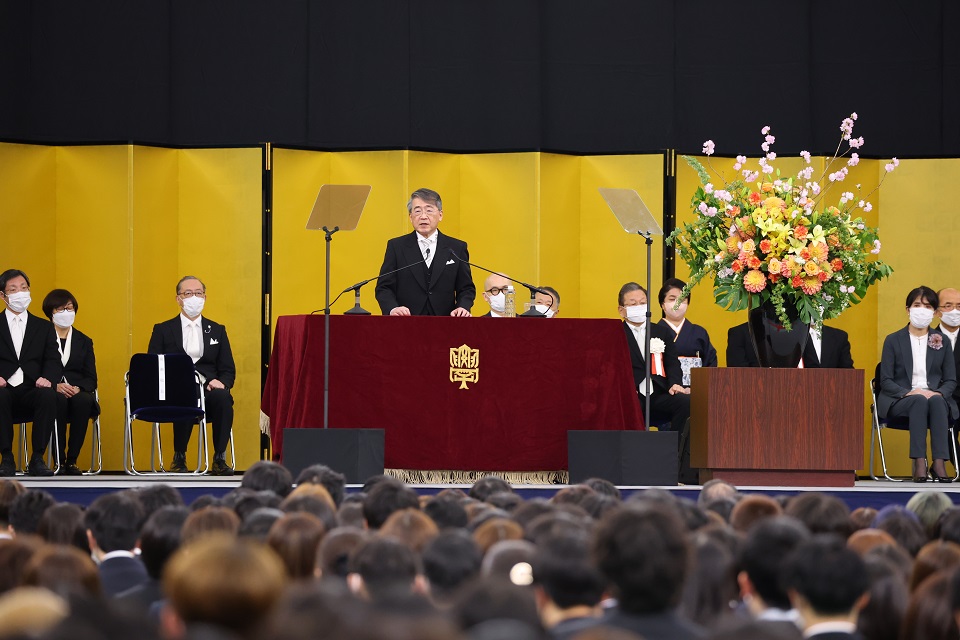News & Event
President’s Address at the 2023 Entrance Ceremony
Hello everyone, and congratulations to our new students on being accepted to Hosei University. My name is Katsuya Hirose, and I am the university President . Welcome to Hosei. Allow me to express my heartfelt congratulations also to your family members, whether they are here with you, or watching online.
You students who graduated from high school this spring and are now starting university, are the cohort whose entire three years of high school coincided with the COVID-19 pandemic. I expect that your life at high school was restricted in various ways, and you were unable to participate fully in the types of activities you had expected to become involved in. You have my deep respect for deciding your future path and earning the opportunity to enroll at Hosei University in such highly restricted conditions. I sincerely welcome you as new members of this university, and will do all in my power to support you so that the life you are embarking on as students will be all that you hope it will be.
Hosei has a university charter entitled Practical Wisdom for Freedom . It sets out in writing our identity as shaped by the university’s history since its founding, and is something we strive to make widely known among everybody associated with the university, including students, faculty and staff, and graduates. Hosei University started 143 years ago in 1880 as Japan’s first private law school, established by three young men who were still in their twenties at the time. Some years had passed since the Meiji Restoration of 1868, which heralded a new era of modernization and Westernization in Japan , but our country still had no constitution or civil code. Japan needed to enact the necessary laws and create a society in which people’s rights were protected by a legal system. Hosei University’s young founders believed that, in order to address that challenge, Japanese society would need professionals familiar with the workings of a modern legal system. That was what prompted them to establish a law school themselves.
The three young men had studied the French language and French law during the period from the end of the Tokugawa shogunate to the Meiji Restoration. They were acquainted with Dr. Gustave Emile Boissonade , who had been invited from France by the Japanese government as a legal advisor. Having persuaded Dr. Boissonade to teach some classes, they managed by themselves to found an institution where students could study the most up-to-date law of the day. At the time, there was still no private university system in Japan. In fact, not only were there no private universities, even the modern school system itself was still in the process of being developed. It wasn’t the case that a higher education system of universities already existed, and Hosei’s founders established a new school in line with that system. Instead, these young men thought that Japanese society needed legal education, so they simply went ahead and established an institution to address that need. As it was Japan’s first private law school, there were no pre-existing models to emulate, and there were also no prescribed formalities to be adhered to. So, the three young men made full use of the means available to them, such as their acquaintance with Dr. Boissonade, and came up with an original solution by themselves.
That law school eventually became a large comprehensive university , which was designated as a private university in line with the school system that subsequently developed, thereby creating the institution we now know. The Hosei University of today is a modern university established and run in accordance with Japan’s legal system, including the School Education Act and the Private Schools Act . Nonetheless, it came into being not as a product of a pre-existing system, but because it was specifically created to meet Japanese society’s need for a type of educational institution that didn’t exist. I want us to value the role this origin story plays in our identity as a university. The Hosei University Charter entitled Practical Wisdom for Freedom expresses the essence of this origin story succinctly, and goes on to articulate the type of university we want to be in the years to come.
At the present time, our wider society is approaching a turning point as the pandemic finally shows signs of abating to some extent. The era we’re entering is referred to as the post-pandemic era, but the course it will take is not predetermined. Our society, and our university, won’t simply return to the way they were until 2019, before COVID. During the pandemic, we sacrificed a great deal due to the restrictions we experienced, but it wasn’t all about sacrifice. Both the university and the wider society also gained opportunities to discover a whole range of new possibilities.
For example, online methods of communication became widely used throughout society. Of course, even before the pandemic, the means to hold online meetings with distant locations existed, and Hosei University too had the equipment necessary to hold such meetings. At that time, such equipment was generally used only to connect particular halls in this university with halls at partner universities to conduct commemorative ceremonies. Now, however, we have an online meeting system that can be used in every single classroom throughout the university. It has become perfectly normal for us to link up with classrooms at universities overseas for joint seminars, or to connect online to discuss regional revitalization strategies with people involved in local industries in our founders’ homeplace, the city of Kitsuki in Oita Prefecture . Now, finally, we’ve reached the point where students can actually start visiting universities overseas again, but that doesn’t mean that online means of communication have lost their value when it comes to preparatory meetings or post-visit debriefing sessions.
On a separate note, even if classes take place in classrooms now, as they did before the pandemic, they’re not the same as they were previously. When we started holding classes in classrooms again after the pandemic, a natural consensus arose that we would be wasting valuable opportunities if we didn’t make the most of students being able to spend time together in the same space. Before the pandemic, we took it for granted that students could gather together in the classroom, so we didn’t see it as a valuable opportunity or feel that it would be a waste not to take full advantage of the possibilities offered by face-to-face contact. Now there’s a widespread awareness that we need to work out how to make the most of being able to gather in person.
Despite this awareness of the issue at hand, however, there are no predetermined solutions. To be honest, I think we still have a long way to go in taking full advantage of the possibilities offered by students coming together in classrooms. Nonetheless, everybody is now aware that this issue exists, and I think we’ll just have to use our ingenuity to gradually develop our own solutions. In fact, universities are not places where the faculty knows all the answers in advance and imparts them to the students; even faculty and staff don’t yet know what form universities need to take in future. But, at this time when society as a whole is searching for a new direction, we can forge the future of our universities together. All members of universities—including you incoming students here today—now have that opportunity. Although feeling one’s way forward to create something new can be hard work, it’s also very rewarding and exciting. I welcome all of you today as collaborators in that effort, and I truly look forward to carrying out Hosei University’s mission together.



